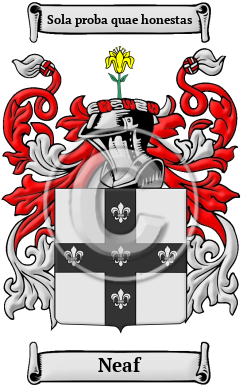| ![Show Contents]() Neaf History, Family Crest & Coats of Arms Neaf History, Family Crest & Coats of Arms
- Origins Available:
Scotland
England Etymology of NeafWhat does the name Neaf mean? The Neaf surname is derived from a place called Nevay in Angus. Early Origins of the Neaf familyThe surname Neaf was first found in Angus (Gaelic: Aonghas), in the territorial origin from Nevay, a former parish now united to Essie. 1 "In 1219 Adam de Neveth was present at the perambulation of the bounds between the lands of the Abbey of Arbroath and the barony of Kinblethmont. Alexander de Neve, a Scots prisoner of war in England, had a safe conduct to return to Scotland in 1422. Thomas Nevay who witnessed the transumpt of a charter in 1450 is doubtless the Thomas Neiff, chaplain in Brechin in 1453." 2 Early History of the Neaf familyThis web page shows only a small excerpt of our Neaf research. Another 256 words (18 lines of text) covering the years 1219, 1453, 1511, 1558, 1579, 1597, 1637, 1647, 1666, 1672, 1792, 1850 and 1870 are included under the topic Early Neaf History in all our PDF Extended History products and printed products wherever possible. Neaf Spelling VariationsSpelling variations of this family name include: Nevay, Neave, Neaves, Nevey, Neve, Neevey and others. Early Notables of the Neaf familyNotable among the family at this time was John Nevay (died 1672), a Scottish Covenanter who after the Resortaion was banished by the privy council to Holland.John Nevay (1792-1870) the Scottish poet, was born in Forfar on 28 January 1792, the...
Another 40 words (3 lines of text) are included under the topic Early Neaf Notables in all our PDF Extended History products and printed products wherever possible. Migration of the Neaf familySome of the first settlers of this family name or some of its variants were: John Neave, who came to Virginia in 1630; Margaret Neave, who arrived at Boston in 1637; Alexander Neave, who settled in Maryland in 1716; William Neaves, who arrived in Pennsylvania in 1852.
| Contemporary Notables of the name Neaf (post 1700) | + |
- Martin L. Neaf, American Democratic Party politician, Candidate for U.S. Representative from Missouri 12th District, 1942 3
The motto was originally a war cry or slogan. Mottoes first began to be shown with arms in the 14th and 15th centuries, but were not in general use until the 17th century. Thus the oldest coats of arms generally do not include a motto. Mottoes seldom form part of the grant of arms: Under most heraldic authorities, a motto is an optional component of the coat of arms, and can be added to or changed at will; many families have chosen not to display a motto.
Motto: Sola proba quae honestas
Motto Translation: Those things only are good which are honorable.
- Lower, Mark Anthony, Patronymica Britannica, A Dictionary of Family Names of the United Kingdom. London: John Russel Smith, 1860. Print.
- Black, George F., The Surnames of Scotland Their Origin, Meaning and History. New York: New York Public Library, 1946. Print. (ISBN 0-87104-172-3)
- The Political Graveyard: Alphabetical Name Index. (Retrieved 2015, November 12) . Retrieved from http://politicalgraveyard.com/alpha/index.html
 |

